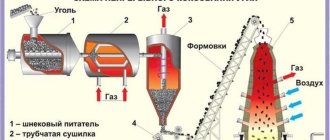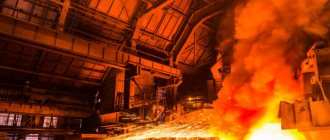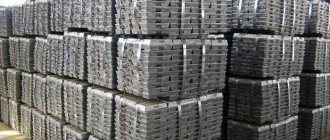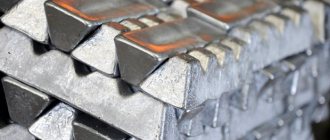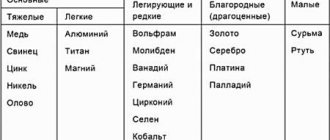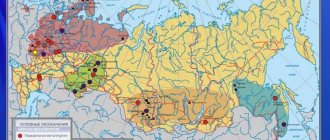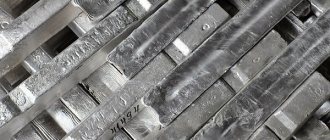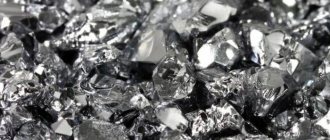Non-ferrous metallurgy is a completely separate part of heavy industry. Methods of extraction, processing and smelting of non-ferrous metals differ significantly from the methods of ferrous metallurgy. In economically developed countries, the ratio of production of non-ferrous and ferrous metals is approximately 15:85. The world's non-ferrous metallurgy is inferior to ferrous metallurgy in terms of the quantity of products produced, but in terms of cost it is hundreds of times higher.
Interesting fact . Every year, metallurgists spend more than 300 billion kilowatt-hours of electricity to smelt non-ferrous metals. This figure is comparable to the annual electricity consumption in India.
Non-ferrous metallurgy is one of the main engines of scientific and technological progress. Non-ferrous metal is the basis of all electrical engineering. Non-ferrous metals are the main raw materials for the construction of aircraft, sea vessels, weapons and ammunition, power plants, electrical infrastructure and so on.
It should be noted that the development trend of non-ferrous metallurgy has been observed only in the last 100 years. At the beginning of the 20th century, non-ferrous metal was produced in volumes of no more than 2 million tons per year. By the end of the 20th century, non-ferrous metallurgy was producing at least 45 million tons of metal annually.
Features of non-ferrous metallurgy
The non-ferrous metals market is characterized by a total monopoly. Manufacturers of raw materials from which final products are obtained can be counted on one hand:
- Alcoa (USA)
- Reynolds Metals (USA)
- Anaconda (USA)
- Asarco (USA)
- Alkan" (Canada)
- Pechinet Eugene Cuhlmann (France)
The production of finished products, as well as the sphere of their sales and many other branches of non-ferrous metallurgy are also subject to monopolization.
It is worth noting that the production of non-ferrous metals is characterized by a higher science intensity than the production of ferrous metals. For the most part, the process of processing ore raw materials is completely unique. Each deposit has its own special chemical composition of the ore. To obtain color, an individual scheme for processing ore raw materials is developed.
The main problems of non-ferrous metallurgy
The non-ferrous metallurgy industry is not without its pitfalls. The main factors that slow down the development of the industry are:
- Environmental pollution
- High power consumption
- Low concentration of metals in ore
Regarding ecology, the main damage to the natural environment is caused in the process of recycling heavy metals. Nickel, magnesium, lead and tin. All these substances poison the environment, ending up in spontaneous landfills and solid waste landfills.
Most non-ferrous metals belong to the refractory category. The production of ready-to-sell products requires approximately 5 times more electricity than the production of ferrous products.
The raw material for producing flowering plants is highly dispersed in the ground. As practice shows, the concentration of non-ferrous metals in ore rarely exceeds 1.5-3%. The record concentration that was recorded is 8%.
Geography of metallurgy
Mining industry
– a complex of industries for the extraction and processing of minerals. Development is carried out both open (quarries) and underground (mines).
Although the share of the mining industry in world industrial production is gradually declining, it continues to have a very large impact on the international geographical division of labor and the geography of the world economy.
It is the mining industry that is associated with bridging the territorial gap between production areas and consumption areas, the formation of intercontinental cargo flows, and the development of new resource areas.
The range of mining products includes dozens of items. No country in the world has a complete set of all types of mineral raw materials. Economically developed countries account for the main shares of the production of chrome ores, lead, zinc, gold, molybdenum, phosphorites, and salts. Developing countries account for the main shares of the production of silver, oil, copper, bauxite, and tin. Nevertheless, in developed countries the share of extractive industries in all industrial production averages 2%, and in developing countries it is 14%.
As a result of the international geographical division of labor in the world economy, eight “great mining powers”
, which extract over 30 types of minerals. This includes the USA, Canada, Australia, South Africa, China, Brazil, India, Russia. To some extent, Ukraine, Kazakhstan, Mexico and some other countries with developed mining industries are approaching them.
Mining powers of the world
It is also impossible not to note countries that stand out for any one major branch of the mining industry.
For Chile, Peru and Zambia it is the copper industry
, for Malaysia, Indonesia -
tin
, for Guinea and Jamaica -
bauxite mining
, for Morocco, USA, China -
phosphorites
.
China remains the main consumer of products from the global mining industry.
The scientific and technological revolution has placed increased demands on the concentration of reserves, on the geographical location of basins and deposits, and on the possibilities for open-pit mining. But it is also necessary to take into account the negative impact of open-pit mining on the environment.
For your information, every year a huge number of different minerals are extracted from the bowels of the earth. At the same time, mining waste alone exceeds 3 billion tons per year. Artificial embankments made of waste rock are called waste heaps.
Terricons
For a long time, the size of metal smelting almost primarily determined the economic power of any country.
Metallurgy
is a set of industries that produce a variety of metals and their alloys, as well as rolled products.
It includes ferrous and non-ferrous metallurgy.
Ferrous metallurgy
– is the production of metals, the basis of which is iron (cast iron, steel, ferroalloys), as well as manganese and chromium.
For your information, 90% of all metals used in production are ferrous metals.
Metallurgical enterprises are engaged in the extraction and beneficiation of metal ores, the smelting of various metals, the production of rolled products, the processing of metals in various ways to obtain specified properties, the processing of secondary raw materials, and the production of auxiliary materials.
At the end of the 20th century, under the influence of the energy and raw materials crises, the pace of development of metallurgy as one of the typical old industries slowed down quite sharply.
First of all, this applies to ferrous metallurgy. Until the mid-70s. this industry has developed rapidly. Then they suddenly slowed down. This slowdown is explained by many reasons: a decrease in the metal intensity of production in the era of scientific and technological revolution, measures to protect the environment from pollution, and an increase in prices for some metals.
The starting materials for ferrous metallurgy are iron, manganese and chromium ores.
The main ferrous metal is iron
, from which steel is smelted, is an alloy of iron with carbon and other elements. The carbon content in steel ranges from 0.1 to 2.14%. Carbon gives iron alloys strength and hardness, reducing ductility and toughness.
Steel
At the beginning of the 21st century, global steel production reached 1.3 billion tons.
At the same time, the proportion between the countries of the North and the South began to change. Nowadays, 1/2 of all global steel production comes from the countries of the South. This “migration” of ferrous metallurgy to developing countries is explained, on the one hand, by the needs of their industrialization, and on the other, by the policy of transferring “dirty” industries from Japan, Western Europe, and the USA to these countries.
Germany, Italy, France, Great Britain, and Canada also produce large amounts of steel.
Leading countries in steel production
The largest steel producing corporation is ArcelorMittal
(Luxembourg).
Historically, iron and steel industries were located near deposits of iron ore (e.g. Lorraine in France, the Urals in Russia) or coking coal (Ruhr in Germany, Donbass in Ukraine), as well as at the intersection of coal and iron ore flows (in Detroit, around Chicago in USA). This traditional orientation still persists in many countries and regions of the world. Later, there was a shift in ferrous metallurgy enterprises towards seaports, where cheap and high-quality imported raw materials were delivered. Almost all factories in Japan are located near the sea, and both ore and coal are transported to them.
Yokohama seaport. Japan
In the United States, the largest steel plant is located on the coast in Baltimore. At the present stage, the location of metallurgical enterprises in areas of metal consumption - large mechanical engineering centers, where scrap metal is used as raw material, steel is smelted and rolled products are produced - has become widespread.
Scrap metal
- a general name for various metal waste, recycled or not recycled in the secondary metallurgical cycle.
Scrap metal
According to experts, hundreds of millions of tons of scrap metal accumulate in the world every year. By replacing raw materials with scrap metal, you can achieve a great effect.
The savings will be 4 tons of iron ore, 530 tons of copper ore, 1.5 tons of coking coal and 7.5 thousand kWh (kilowatt hour) of electricity.
The production base of ferrous metallurgy consists of full-cycle enterprises: cast iron - steel - rolled
.
Rental
– the final, most valuable product of the entire ferrous metallurgy cycle. Its cost is 2-5 times more than the cost of the steel from which it is made. Rolled products are very diverse (up to 20-30 thousand types and names).
Rental
More than 450 million tons of rolled products are supplied to the world market annually. Its main exporters are Russia, Japan, China, Germany, Ukraine, and its importers are the Republic of Korea, Germany, and the USA.
Non-ferrous metallurgy
is the production of more than 70 metals with valuable properties (copper, aluminum, lead, zinc, etc.).
Unlike ferrous metals, the content of non-ferrous and rare metals in ores is extremely low. To obtain 1 ton of non-ferrous metal, hundreds to tens of thousands of tons of raw materials are mined and processed. More than 65% of ores are mined using the most economical open-pit method, which ensures comprehensive extraction of metals from the subsoil.
According to their physical properties and purpose, non-ferrous metals can be divided into heavy (copper, lead, zinc, tin, nickel), light (aluminum, titanium, magnesium), precious (gold, silver, platinum) and others (this usually includes rare (uranium) and refractory (tungsten and molybdenum) metals.
The main non-ferrous metals are aluminum, zinc, lead, and copper.
Non-ferrous metallurgy is focused on areas where raw materials are extracted, areas with cheap electricity, and transport routes.
Leading countries in copper
: Chile, China, Peru, USA, Australia, Russia, DRC.
Leading countries in copper smelting
Ores of light non-ferrous metals, especially aluminum
, in terms of the content of useful components they resemble iron ore and are quite transportable. This is why the aluminum industry is another striking example of an industry with a strong territorial gap between the extraction of raw materials and the consumption of the finished product. More than 2/5 of the bauxite mined in the world is exported.
The largest reserves of bauxite (raw material for the aluminum industry) are found in Brazil, Jamaica, Guinea, and Australia.
Leading countries in zinc
: China, Peru, Australia, India, USA, Canada.
Leading countries in zinc smelting
Leading countries in lead
: China, USA.
Leading countries in nickel
: Russia, Canada, Australia, New Caledonia (mainly mining), Indonesia.
70 % tungsten
gives by China.
Leading countries in gold
: China, Russia, Australia, USA, Peru.
Leading countries in gold production
In the last two or three decades in the USA, Western Europe, and Japan, the development of non-ferrous metallurgy, as well as ferrous metallurgy, has slowed sharply. In developing countries, on the contrary, this industry began to grow quite quickly. This happened due to strict environmental policies in economically developed countries, which in this way are trying to reduce the harmful impact of “dirty” industries on the environment.
Large metallurgical centers are cities with an unfavorable environmental situation. Open-pit mining causes great harm to nature.
